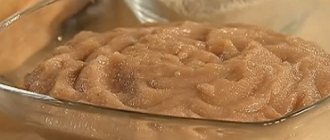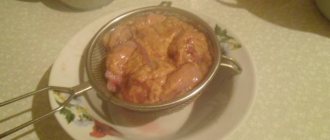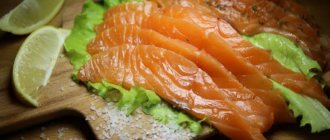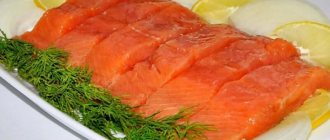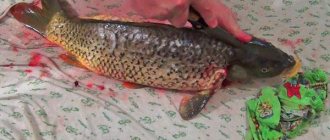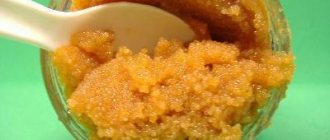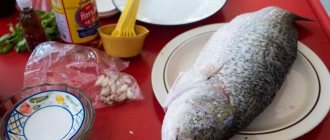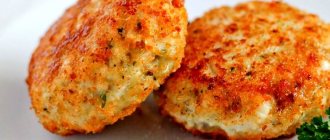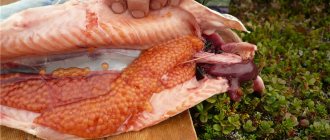How to properly salt fish roe according to GOST?
GOST is a standard that obliges producers to adhere to clearly defined norms and rules in the process of producing fish caviar.
Fish caviar, like all other products that are produced in accordance with GOST, has the best quality and the most pleasant taste.
At home, it is unlikely that you will be able to pickle the product according to GOST, since there are certain points that cannot be observed at home. Nevertheless, you can still salt the fish according to the most similar recipe.
- The fish whose caviar we will use must be of high quality. It is acceptable to pickle caviar from fresh, frozen and chilled fish.
- The fish may be slightly deformed, but the shells with eggs cannot be damaged.
Prepare foods:
- Fish caviar – 1 kg
- Salt – 85 g
- Refined vegetable oil – 220 ml
- Water – 3 l
Caviar can be used fresh or frozen. If the product is frozen, be sure to wait until it is completely defrosted. Do not experiment with quick ways to defrost caviar, that is, do not use boiling water, a microwave oven, a battery, or any other similar methods. It is quite logical to assume that in this way you will boil or steam the caviar, but will not defrost it properly.
Salted
- Next, we wash the eggs with caviar in cool water and proceed to the most labor-intensive process - separating the film from the caviar itself.
- This can be done in a variety of ways, all of them definitely deserve attention. However, before you choose any of them, analyze the size of your product. Caviar can be small, medium and large. Based on its size, choose the most suitable method. For example, it is best to clean large caviar with a mixer, while smaller caviar is cleaned with a fork and boiling water.
- If you use a mixer, place all the caviar in eggs in a deep container, turn on the device at minimum speed and carefully lower it into the container. If desired, you can carefully cut the gaps, this will speed up the process of winding the films onto the mixer whisk. Next, simply remove the eggs from the whisk and throw them away, and collect the remaining films from the container with your hands.
- If you use a fork, stick to this technology. We carefully cut the ovaries with caviar, as if opening them. Place the product in a container and fill it with fairly hot water, but not boiling water. You don’t need to pour a lot of water, otherwise the delicacy will cook. For 1 kg of caviar you need to take approximately 0.5 liters of water. After pouring the liquid into the container, immediately begin to lightly beat the caviar with a fork. Gradually, the films will wrap around the cutlery, thereby separating from the valuable product.
- Now we place all the caviar in a fine-mesh sieve and rinse it under cold running water. Let the water drain completely and place it in a container.
- At this stage, pour salt into the container and, using a fork, gently beat the caviar mass until white foam appears. Many people will think about helping themselves with a mixer, but this should not be done. Even the slowest speed will most likely turn the caviar into a paste-like mixture.
- Now pour oil (150 ml) into the container and beat the caviar by hand again. The mass will thicken and become more homogeneous, but the eggs will remain intact.
- Be sure to wash and sterilize the container in which you will store the delicacy.
- Transfer the finished product into containers, add about a couple of inches of oil and cover with a lid.
- We place all containers with the product in the refrigerator.
- It is necessary to keep the caviar in this state for at least 5 days, and preferably 6-7.
Salting red caviar: a classic recipe
This is a dry technology that does not involve the participation of water.
Ingredients needed
- red caviar - 500 g;
- salt - 3 level tablespoons.
Recipe (steps step by step)
Step 1.
Gut the fish, remove and wash the fish, remove the film.
Red caviar - dry salting at home
Step 2
. A layer of salt (quite dense) is placed on the bottom of the pan, an even layer of eggs is placed, and a little sprinkle is also sprinkled on top. Several more layers are created in exactly the same way.
Step 3
. Place the product in the refrigerator, and after 3-4 hours lightly salted red caviar is ready. A medium-salinity product will be ready in 10-12 hours (just put the caviar in the refrigerator overnight).
How to properly salt flounder caviar: recipe
The caviar of this fish is very useful for our body, as it contains a large amount of vitamins and microelements.
Salted flounder caviar is a delicious appetizer that can be safely served on a holiday table.
- Fresh flounder caviar – 1 kg
- Salt – 60 g
- Sugar – 20 g
- Mayonnaise – 100 ml
- Sunflower oil – 50 ml
- Lemon juice – 2 tsp.
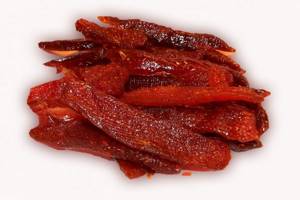
Caviar
We wash the caviar in the eggs under running cool water. Next, carefully cut each joint along its entire length. Turn the caviar inside out, and then use a spoon to separate the product from the film.
- Place the delicacy in a deep plate and add salt, slowly stirring the caviar so as not to damage the grains.
- Now add granulated sugar and mayonnaise and mix the contents of the plate again.
- Mix the oil with lemon juice and pour this mixture into the caviar, mix the ingredients thoroughly.
- Place the almost finished delicacy into a sterilized container, close it with a lid and place it in a cold place.
- It is enough to wait 12-24 hours. so that the caviar becomes suitable for eating.
With lemon juice and herbs
For pickling, you can use various spices and herbs to taste.
Required ingredients:
- caviar – 500 g;
- salt – 2 tsp;
- vegetable oil – 100 ml;
- lemon – 1 pc.;
- ground white pepper;
- greenery.
Preparation:
- Pour the cleaned caviar into a large plate.
- Salt and pepper.
- Pour in oil and squeezed lemon juice.
- Cover tightly with a lid. Leave in the refrigerator for 120 minutes.
The delicacy is served chilled with chopped fresh herbs on top.
How to properly salt bream caviar: recipe
Bream is a very affordable fish today, and so is its caviar. In addition, the taste of the caviar of such fish is no worse than red caviar, the main thing is to salt it correctly and tasty.
- Fresh bream caviar – 1 kg
- Salt – 50 g (and another 100 g for processing)
- Refined vegetable oil – 200 ml
IMPORTANT: During the salting process, bream caviar is recommended to be subjected to heat treatment to make it safer to consume.
- Therefore, we wash the caviar under cold water and place it in a deep plate.
- Pour about 0.5 liters of water into the pan and add 50 g of salt. We boil the liquid and pour it over the caviar, which is still in the eggs. Immediately we begin to gently beat the caviar with a fork; due to the action of boiling water, the film will curl up, tear and begin to move away from the caviar. Drain the water from the product. This procedure should last no longer than 1 minute so that the caviar does not cook.
- After this, remove all the film that has separated from the container.
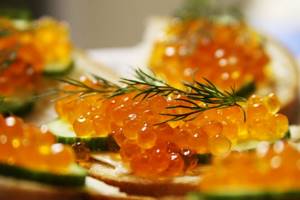
Ready bream caviar
- Using the same principle, cook another portion of the salty solution and pour in the caviar again, beat it with a fork and free it from the remaining film. Drain the liquid and, if necessary, clean the eggs from the caviar with your hands.
- Add 50 g of salt to the plate with the delicacy and mix the ingredients so that all the caviar is salted.
- Now pour oil into the caviar and let it salt for 12 hours.
- Bream caviar prepared in this way has undergone heat treatment, so its consumption will be relatively safe.
- The product must be stored in a cool place.
Salting frozen caviar
Sometimes it becomes necessary to salt red fish caviar that has been previously frozen. In this case, it is necessary to properly defrost the product naturally (in the refrigerator) so that sudden changes in temperature do not negatively affect the eggs. Due to aggressive defrosting, they can lose not only their shape, but also their taste. After this, all that remains is to take out the caviar, sprinkle with vegetable oil and mix gently.
Preparation:
- Free the eggs from excess films.
- Boil water, combine with salt.
- Pour the caviar completely with the resulting and slightly cooled brine for 7 - 10 minutes.
- Drain the liquid and dry the eggs on a disposable towel.
- Place the product in a glass jar and sprinkle with oil, stirring gently.
Salted caviar extracted from defrosted fish must be used within a short time.
How to properly salt pollock caviar: recipe
Pollock caviar, of course, is not as valued as red or black caviar, but it still has benefits for our body. Pollock caviar is a healthy snack that is accessible to almost everyone.
- Pollock caviar – 1 kg
- Salt – 140 g
- Water – 1 l
- Ground allspice
- Olive oil – 100 ml
- Fresh cilantro – 1 tbsp. l.
We wash the caviar under running water and transfer it to a deep container. Boil half a liter of water and dissolve 50 g of salt in it. Pour the caviar into the eggs with this solution and quickly mix the liquid in the container using a fork. Drain the water. At this stage, the film will begin to peel away from the calf.
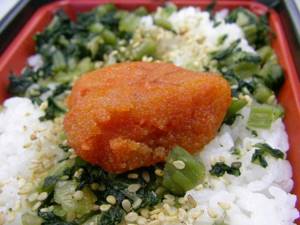
Home-salted caviar
- We carry out the procedure again, beat the caviar in the eggs with a fork, separating them from it in this way. Drain the liquid and remove the remaining film with your hands.
- Place the pollock caviar on cheesecloth and let the liquid drain. There will also be some films left on the gauze that you cannot pick out with your hands.
- Now transfer the product into a container and add the remaining salt and pepper to it. Using a fork, gently whisk the caviar until it becomes a little thicker
- Wash the cilantro, dry it and chop it.
- We sterilize the glass container and place the caviar in it almost to the top of the container.
- Fill with oil and add a little cilantro.
- We close the containers with lids and put the delicacy in a cold place to salt.
- You can eat this product after 12-24 hours.
How to properly prepare caviar for salting
What can you cook from caviar? Any dish, including caviar for salting, requires preliminary preparation of the product. It includes the correct removal of eggs from a fish carcass and the release of eggs from films.
At the first stage, you need to act very carefully to avoid damaging the integrity of the ovaries and getting bile into the product. There is no need to carry out any complex manipulations, just cut the abdomen and separate the sacs with your fingers from the internal cavity. The main thing is extreme caution.
The second stage is also called punching. The release of a small amount of caviar can be done using improvised means such as a sieve, colander or grater. The main thing is that the holes in them are sufficient for the passage of fish eggs, but not very large. The films of the bag are cut, and then the mass is ground through a suitable tool with holes.
How to properly salt carp caviar at home: recipe
Salted carp or common carp caviar turns out to be very tasty. Of course, such a product can be salted using a classic recipe, which is also suitable for salting the caviar of other fish, but we invite you to experiment and try to prepare delicious caviar using the following recipe.
- Carp caviar – half kg
- Olive oil – 120 ml
- White onion – 1 pc.
- Lemon – ¼ pcs.
- Salt – 25 g
- Ground allspice
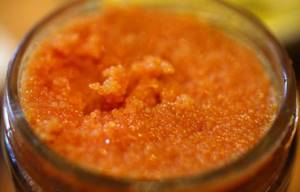
Carp caviar
Initially, we wash the caviar and transfer it to a deep plate.
- Boil 750 ml of water in a saucepan, add 1 tsp. salt.
- Pour the hot solution over the caviar in the jars and beat it with a mixer. Turn on the device at the lowest speed. The film will wrap around the whisk and you just need to remove it from it and throw it away.
- Next, place the caviar in a colander with a fine mesh and let the solution drain completely from the caviar.
- Now we transfer the caviar into a sterilized container and add 25 g of salt to it, mix.
- Squeeze the juice from the specified amount of lemon and mix it with oil.
- Peel the onion and cut it into half rings, place it on the caviar.
- Pour oil and lemon juice over carp caviar.
- Close the container with a lid and place in a cool place.
- You can try the deliciousness after 12 hours. after salting.
Fish roe pancakes
Ingredients:
- one and a half kilograms of pike perch caviar (or any other fish);
- a little flour;
- egg;
- carrot;
- bulb.
They work like this: grate the carrots on a (medium) grater, peel and chop the onion. Remove the films from the caviar and grind in a meat grinder. Mix all the products, add flour. Break the egg, salt and pepper, mix thoroughly. Heat a frying pan with vegetable oil and pour the dough onto it using a ladle (in a thin layer). Pancakes are fried on both sides until golden brown.
How to properly salt silver carp caviar at home: recipe
Silver carp is a fish that can be found in any more or less large supermarket, not to mention markets and fish pavilions.
The availability of this product allows us to eat it in sufficient quantities, so all that is needed is to buy fresh and high-quality fish with caviar and salt the delicacy.
- Silver carp caviar – 1.5 kg
- Water – 4 l
- Salt – 415 g
- Vegetable oil – 220 ml
- Lemon – half pcs.
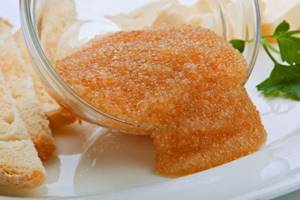
Salt at home
We wash the caviar under running water. Next, we carefully cut each yastik along its entire length. We take a sieve or colander, the size of the holes in which will allow the eggs to fall through without damage. Lightly pressing on the eggs, we wipe the caviar through a sieve; the caviar, when separated, will fall into the container under the sieve, and the films themselves will remain in the sieve.
- Now boil the water. Take 1 liter of water and add 100 g of salt to it. Pour this solution over the caviar. We repeat this procedure 3 more times. This must be done, so we will protect ourselves from infection with various ailments.
- Place the silver carp caviar in a sieve and let the solution drain completely.
- Then place the caviar in sterilized glass containers, add salt at the rate of 1.5 tsp for a full 1 liter jar. Beat the caviar with a fork.
- Pour boiling water over the lemon and squeeze out the juice. Mix it with oil.
- Place the resulting mixture in a container with caviar.
- Close the container with a lid.
- You can try the treat after 12 hours. after salting.
How to pickle red caviar: choosing fish
This is another important point, because red caviar is almost always sold only in salted form. It is clear that it can only be found among representatives of salmonids:
- salmon itself;
- salmon;
- chum salmon;
- pink salmon;
- trout;
- red salmon;
- taimen and others.
The most convenient in terms of price/quality ratio are pink salmon and chum salmon. Therefore, it is clear that you need to buy ungutted fish and a female.
First of all, you should not pay attention to the size, because the male may simply not survive to adulthood and end up in the net, and the female may be caught quite large. Therefore, you need to pay attention to more reliable signs - the appearance of the fish.
Let's look at the most typical of them using pink salmon as an example:
- Of course, it is best to choose chilled fish, because it is unlikely that you will be able to see anything on frozen fish due to the tight packaging and layer of ice. However, even in this case, differences in the head are visible to the naked eye. In the male (bottom) it is more elongated and sharp, with a predatory appearance; in the female (above) it is rounded and more neat.
- If you look closely and compare several specimens, you can see that the female pink salmon is more inconspicuous in appearance. Its color (above) is not so pronounced, and the color transitions are smoother and softer. The male (shown below) has a rich color and looks more attractive.
- Thus, mainly the male and female are compared based on the structural features of the head, since this is a more reliable sign.
How to properly salt pike caviar at home: recipe
Today, pike caviar is valued no less than red caviar, and its cost rarely pleasantly surprises the buyer. At the same time, such a product is very healthy and tasty, so it’s definitely worth trying homemade salted pike caviar at least once.
- Fresh pike caviar – 1 kg
- Salt – 80 g
- Refined sunflower oil – 100 ml
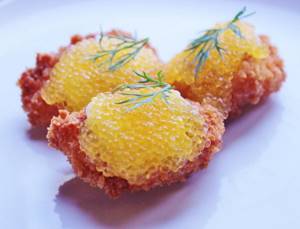
Pike caviar
We wash the caviar and put it in a deep container.
- We will separate the film from the caviar using a mixer. Place the mixer in the container with the caviar and turn it on at the lowest speed. After a few minutes. You will notice that the joints are tearing and starting to wrap around the mixer attachment. This way we clean the product from films.
- Transfer the cleaned pike caviar to a plate, add salt and beat with a mixer or fork until white foam appears.
- Now pour in 70 ml of oil and stir the product in the plate a little more.
- Place caviar in sterilized glass jars and pour a little oil on top.
- We close the containers with lids and put them in a cold place for 1 week.
How to quickly and deliciously pickle caviar in brine
You can also learn how to salt caviar in brine. This is a very fast method that only takes 3 hours.
Ingredients needed
- 500 g red caviar;
- 3 tablespoons salt;
- 1 teaspoon sugar (to taste).
We will act like this:
Step 1.
First, prepare the brine itself: bring 1 liter of water to boiling water, add salt and sugar, stir quickly and turn off the heat.
Step 2.
While the brine cools, we process the fish and extract the eggs.
Step 3.
Transfer the product to the completely cooled brine and leave it for literally 20 minutes.
Step 4.
After this, simply drain the water through a colander and leave the eggs to lie for another 3 hours (in the refrigerator).
Step 5.
Then you can enjoy this wonderful dish - home-salted red caviar.
How to salt fish roe dry?
Salting caviar using the so-called dry method, that is, without brine, is a very risky undertaking. However, gourmets and lovers of crumbly caviar still salt the product in this way.
- Fresh fish caviar – 1 kg
- Salt – 60 g
- Granulated sugar – 20 g
Wash the caviar. This method can be used for salting caviar, both in jars and without them. If you clean caviar from films, do it using any of the methods described above. If you want to try salting the caviar directly in the eggs, then wash them, dry them and place them in a container.
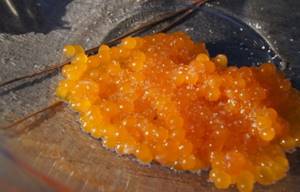
Can be salted dry
- Sprinkle the caviar with salt and sugar. If we add salt in jars, then rub them thoroughly with the mixture; if without them, we mix the caviar with the mixture with a fork.
- Transfer the product to a sterilized container and salt for 5-12 hours.
- If desired, you can then flavor the yummy with sunflower oil. The caviar, which is salted in eggs, is freed from them after salting by cutting them with a knife and separating the caviar with a spoon.
As you can see, not only red and black caviar have nutritional value. Caviar of any other fish can also be tasty and healthy.
Pickling recipe options
Recipes for salting crucian carp caviar at home are very diverse. The simplest cooking method involves just a few steps. After placing the main ingredient in a bowl, salt is added, after which the caviar is allowed to stand for a while undisturbed, and the product is ready for use.
This method has a number of significant disadvantages. River fish often become the target of attack by various parasites, many of which live in the eggs. Poor treatment can lead to infection of the human body. It is not recommended to use this method unless absolutely necessary. In addition, caviar retains its repulsive fishy aroma. Fishing enthusiasts recommend paying attention to other salting methods.
Pickling recipe No. 1
Cooking will take no more than 30 minutes, and if the storage container is well sterilized, caviar can be stored in the refrigerator for more than a month.
- The first stage involves heating and cleaning the crucian roe. Prepare brine solution. Add 100 g of table salt to one liter of water. The solution is heated to a boil, removed, and crucian caviar is added. High temperature will get rid of possible parasites. Stir the product in the solution for three minutes and drain all the liquid. We repeat the procedure three times with previously prepared new brine. At the last stage, the liquid should become more transparent.
- After working with brine, we transfer the crucian caviar to a sieve to drain all excess liquid. If there is no suitable tool, you can spread the product in an even layer on a board, which is placed at a slight degree of inclination. The liquid will begin to drain and the eggs will dry well. The second stage takes about 15 minutes.
- In the third step, we will need a well-washed liter glass jar. Pour vegetable oil in the amount of two tablespoons into the bottom of the container. Crucian caviar is placed on top, filling a maximum of 75% of the volume. Next, add a teaspoon of salt and mix all ingredients well with a fork. Then the jar is filled almost to the top with the remaining caviar and covered with approximately a 5 mm layer of vegetable oil.
- The jar, closed with a plastic lid, is placed in the refrigerator for at least several hours, or better yet, overnight. The advantages of such cooking include the absence of odor, attractive appearance and disinfection of the product.
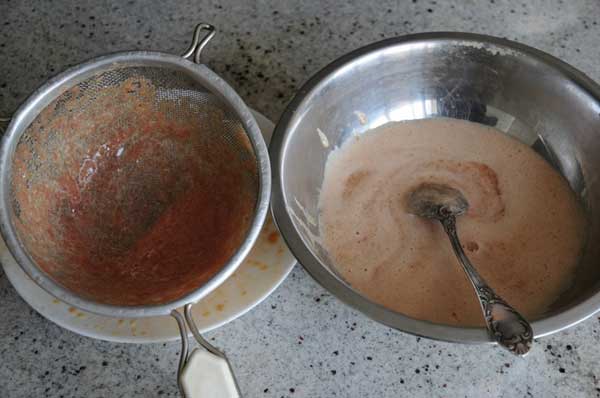
Recipe No. 2
You need to prepare an enamel pan in advance.
- The product is placed on a convex plate or bowl.
- If the film is not separated, pour boiling water over the caviar for 2-3 minutes, gently stirring with a spoon to remove waste.
- In a second bowl, prepare a solution of salt and warm water.
- Crucian caviar is laid out in the prepared composition. Extra inclusions at this stage are not scary.
- The caviar is mixed evenly to destroy parasites, give the product a yellowish tint and good salting.
- Next, leave the mixture alone for 15 minutes.
- Then, using gauze or a similar material, squeeze out the excess liquid from the caviar without much effort.
- The finished useful ingredient remains on the material, after which the caviar is placed in a storage container. A dish prepared this way can be stored for several days.
We recommend reading: Recipes for cooking char, making it tasty and healthy
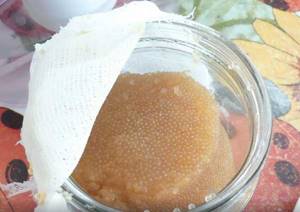
Recipe No. 3
Add water to an enamel pan, more in volume than the caviar being processed in a ratio of 1 to 3. Add salt, bay leaf, peppercorns or ground pepper to the boiling liquid. After removing the boiling water from the stove, add caviar and close the lid for 15 minutes. Afterwards, the contents must be filtered using gauze so that all the liquid is glass. Cooked caviar can be stored in the refrigerator at a temperature of 1-6 degrees for up to a month.
Recipe No. 4
This option is well suited for processing large quantities of caviar. For 2 kilograms of product, up to 8 liters of water are required. If the film still envelops the product, it can be effectively cleaned off with boiling water. After treatment with boiling water, the caviar is washed with cold water to remove small particles of film. This procedure can be repeated up to 15 times until high transparency of the liquid is achieved.
After washing, a knot is formed using gauze, which is suspended to drain the liquid. If you plan to eat crucian caviar within two weeks, add a few pinches of salt for every half kilogram and leave it in the refrigerator for a day.
For a shelf life of up to 2 months, the caviar is placed in brine. To cook 1 kilogram of product, mix 4 liters of water with 5-6 tablespoons of salt. The caviar is placed in this liquid for 15 minutes and then washed with cold water.
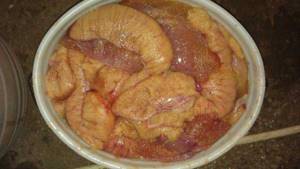
Fisherman's style caviar recipe
- It is necessary to clean the caviar from the films.
- To disinfect, the product is scalded several times with boiling water.
- Crucian caviar is added to a strong salt solution. The brine must have a large salt capacity so that unbound eggs end up on the surface.
- After soaking in the solution for an hour, the caviar can already be used as food, but ideally it is recommended to let it sit for 24 hours.
How to prepare Royal salad (with chum salmon caviar)
Salad ingredients:
- 15 king prawns;
- 50 g caviar (chum salmon);
- 300 g fresh cucumbers;
- 0.5 apples;
- avocado (2-3 fruits);
- 50 g pine nuts.
The sauce is prepared from:
- garlic (1 clove is enough);
- 20-30 ml lemon juice;
- 50 ml olive oil;
- 10 g mint (chopped).
It’s prepared like this: first, the pine nut kernels are fried. Then the cucumbers are cut into semicircles, and apples and avocados are chopped into small pieces. All ingredients are combined with caviar and shrimp. Season with a sauce of crushed garlic, butter, chopped mint and lemon juice.
Ikryaniki (fish roe cutlets): recipe
Externally, fish roe cutlets resemble pancakes, to which a little cabbage (white cabbage), oatmeal, wheat or corn flour, boiled rice, semolina, onions, carrots, garlic, as well as eggs are added to give it “fluffiness” and maintain its shape. spices and seasonings. The main ingredient of the dish is caviar of both sea and river fish.
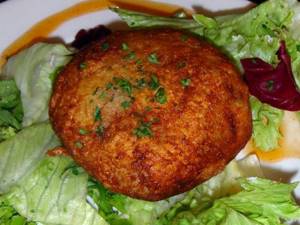
To prepare cutlets according to the proposed recipe (caviar), use:
- cod caviar (fresh frozen) - 1 kg;
- fresh eggs - 2 pcs.;
- peeled potatoes (medium size) – 1 pc.;
- two onions (onions); lard (salted or fresh) - 120 g;
- semolina - 3 tbsp. l.;
- salt and pepper (ground).
Peculiarities of preparation: caviar (cod) is slightly defrosted, released from the eggs and left for final defrosting. Next, it is placed in a convenient container and pounded using a wooden pestle.
The salt is removed from the salted lard, the product is washed in water and cut into very small cubes. The onion is chopped and sautéed. All ingredients are mixed, semolina is added and the mixture is left to “rest” for 40 minutes.
After the semolina swells, beat in eggs, grated potatoes and season to taste. Place the formed cutlets into a (heated) frying pan using a measuring spoon and fry on both sides until golden brown. Serve the dish with sour cream or sauce (sour cream).
